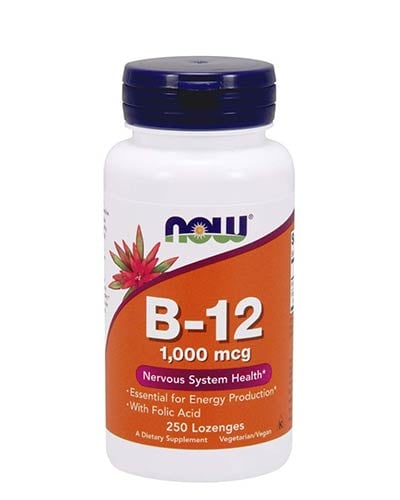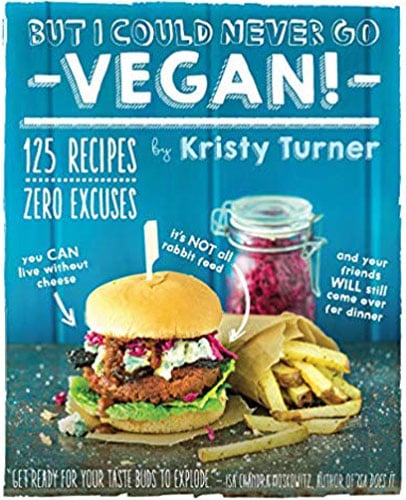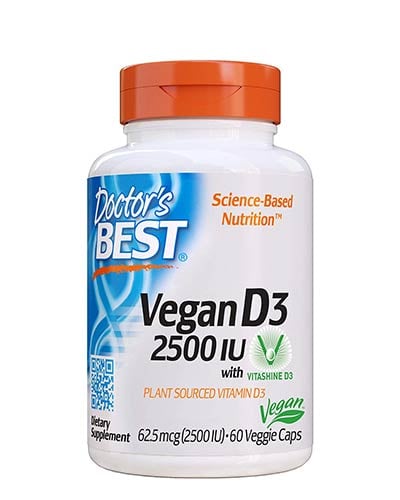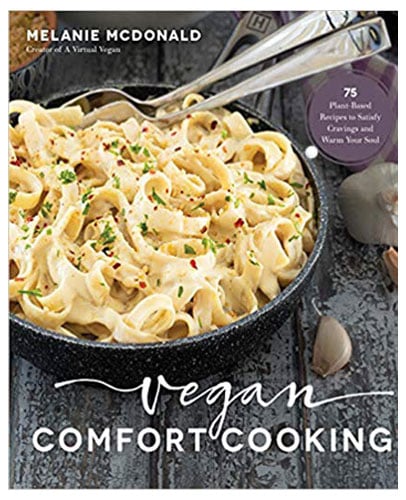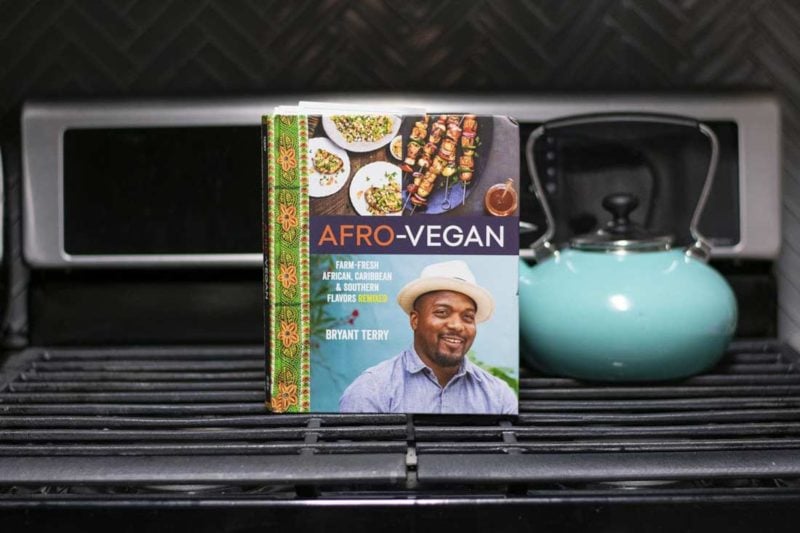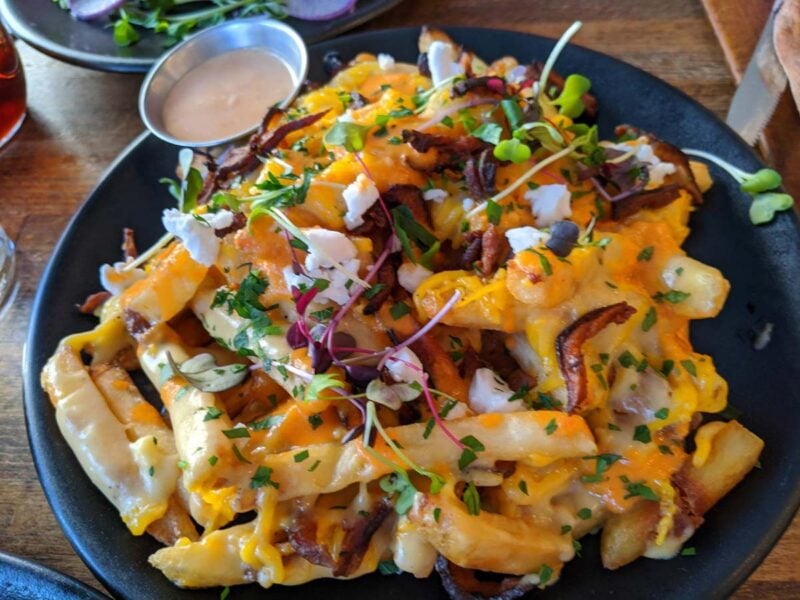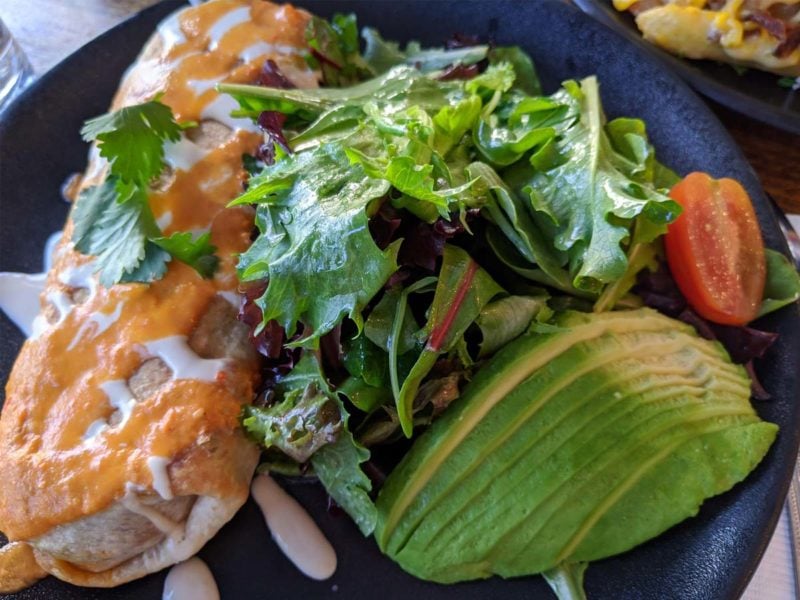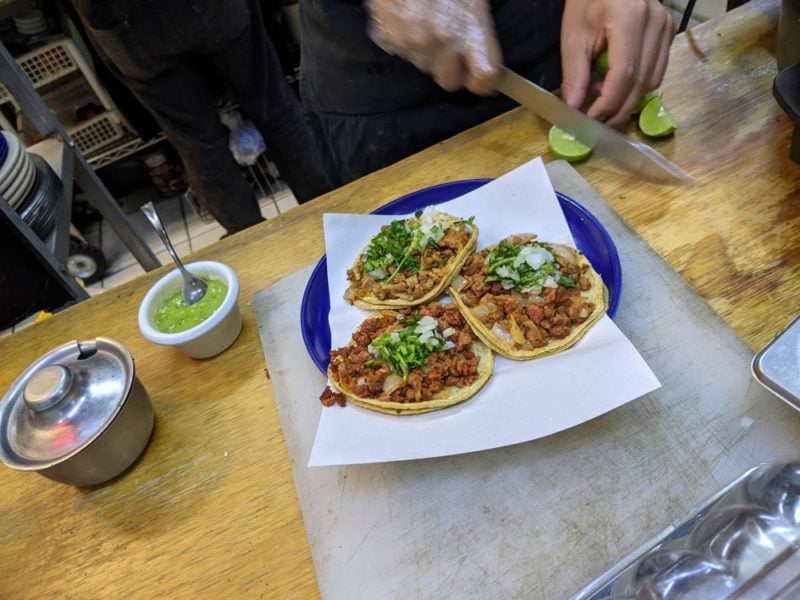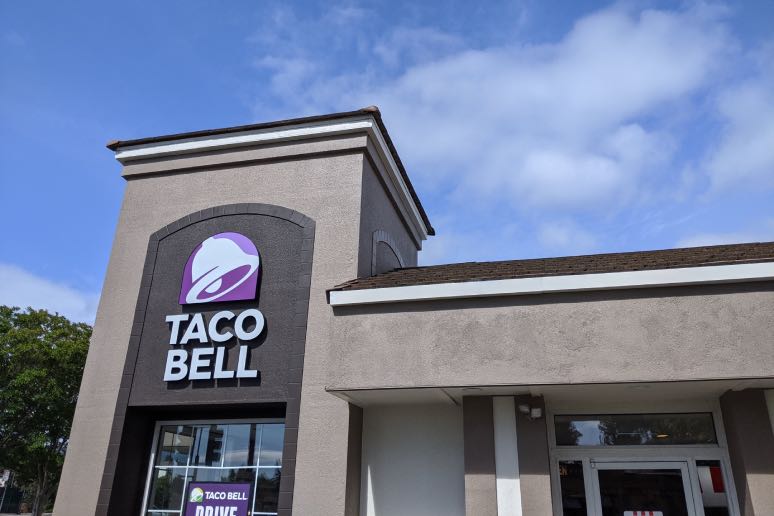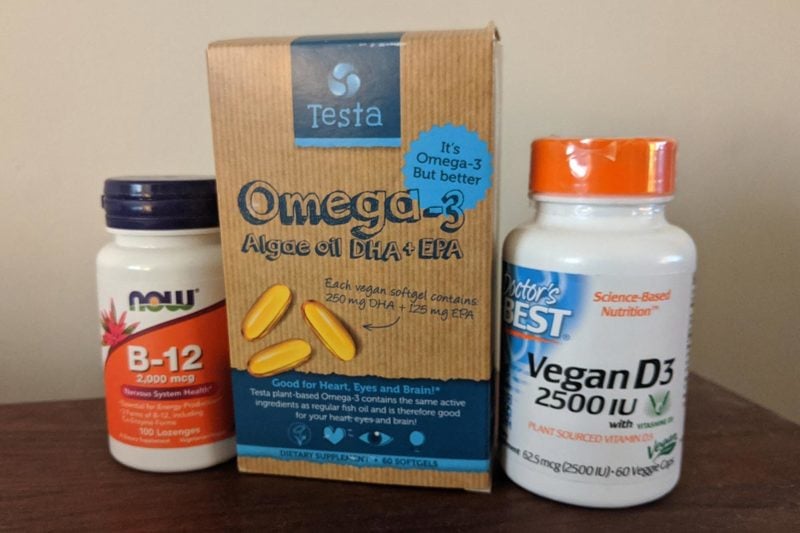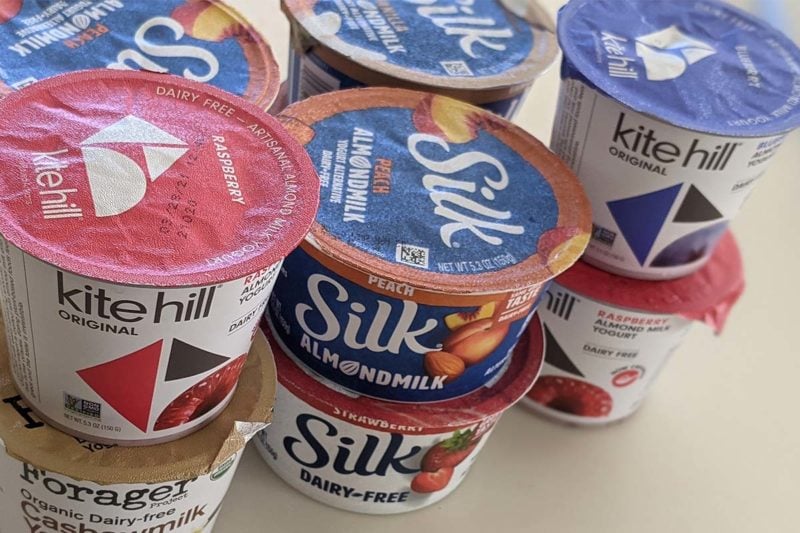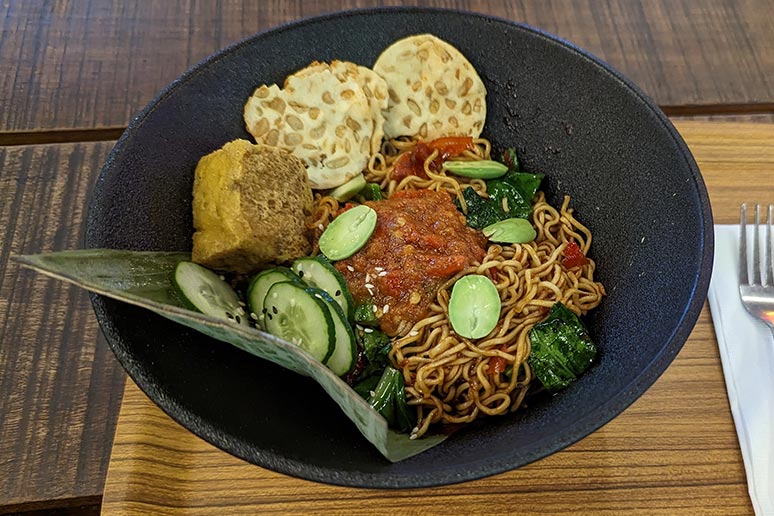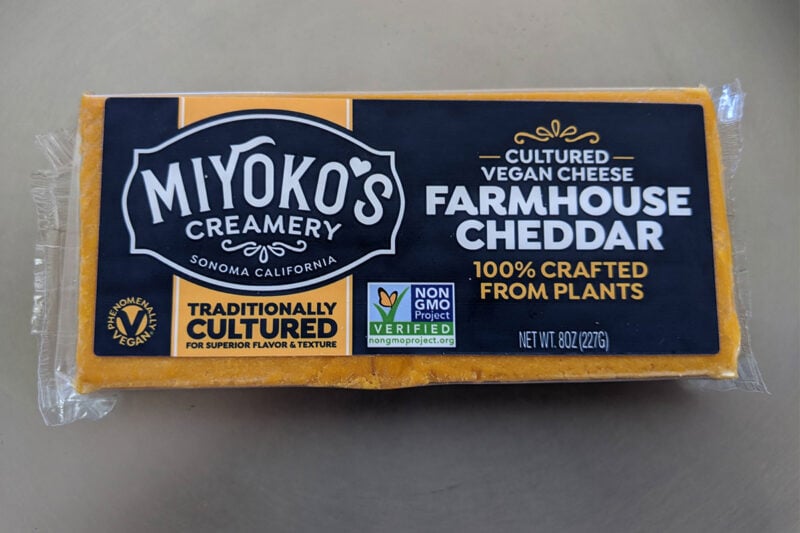Why go vegan? The elevator pitch laying out the best reasons crams several compelling points into just a few seconds. It goes something like this:
A vegan lifestyle prevents a tremendous amount of animal slaughter and suffering. It offers a potent way to shrink our environmental footprint, especially in regard to climate change. And a well-planned vegan diet can fuel the highest levels of fitness, while reducing our risk of various chronic diseases. Plus, the food is insanely delicious and it becomes more plentiful every year.
The above sentences get us off to a nice start, but they don’t begin to do the subject justice. Indeed, getting up to speed on every important reason to go vegan would require months of reading. You would have to explore topics like plant-based nutrition, animal rights philosophy, and the exploitation of slaughterhouse workers. You’d also need to delve into the damage the meat industry inflicts on human health and the environment. There are dozens of other relevant subjects to consider, but you get the idea.
That said, we have to start somewhere. Learning the essentials doesn’t take long. This essay explains the strongest reasons to go vegan, and you can finish it in under an hour.
As we’re about to see, ridding your diet of animal products delivers remarkable benefits. You may never encounter a topic more worthy of your attention.
Defining a Vegan Diet
Vegan diets exclude all foods produced by or derived from animals: meat, fish, dairy products, eggs, and honey. Conversely, you can define veganism as a diet based entirely on plants.
Many vegans go beyond diet to remove animal exploitation from their entire lifestyle. They’ll avoid clothing made of wool and won’t buy leather furniture. Nor will they visit zoos or purchase cosmetics tested on animals. While such steps deserve consideration, to keep this essay concise I will focus entirely on diet.
The Virtues of Plant-Based Diets
Even if this essay doesn’t persuade you to go vegan, it may inspire you to gravitate toward a “plant-based” diet. While vegan diets exclude all animal products, plant-based diets offer some wiggle room. If you see the appeal of going vegan but don’t feel gung ho about it, plant-based diets offer an easily-reached middle ground.
Pretty much every food politics writer worth taking seriously—including Michael Pollan, Mark Bittman, and Eric Schlosser—advocates diets based heavily on plants. All it takes to go plant-based is to make a point of eating vegan foods whenever convenient. You can follow a primarily plant-based diet and still eat Thanksgiving turkey or a summer barbecue.
Perhaps the best reason to go plant-based relates to the lack of a sensible counterargument. In all my years of writing about food politics, I’ve never once seen anyone (other than a few paleo diet fanatics) deny the advantages of eating mostly plants. Eating more fruits and vegetables can significantly reduce risk of chronic disease. And of course, plant-based diets also keep farm animals from slaughter, while simultaneously protecting the environment.

Shifting to a plant-based diet often initiates a virtuous cycle. By eating plant-based, you’ll inevitably discover one healthy and delicious food after another. And that will in turn trigger a cascade of positive dietary changes.
The Joy of Exploring Plant-Based Foods
All it takes to eat plant-based is to regularly try new vegan foods. Inevitably, you’ll discover delicious possibilities that will become part of your everyday diet. So, as time goes by, your diet may become predominantly vegan without any concerted effort on your part. Plenty of current vegans transitioned by sliding down the plant-based slope.
A number of cute neologisms can inspire easy-yet-meaningful commitments: reducetarian, flexitarian, chegan, plant-strong, and even veganish. If any of these terms resonates with you, just grab ahold of it and start thinking along those lines.
Several other related concepts might also encourage you to eat more plant-based meals, including: Meatless Mondays, Mark Bittman’s Vegan Before 6:00 plan, or trying out a vegan diet for a week or a month.
Why Go Beyond Plant-Based?
Plant-based diets make all kinds of sense, but let’s also consider the advantages of going further and becoming vegan. When you eat vegan, you slam the door shut on countless disagreeable things—especially animal suffering.
Animal Cruelty in Agribusiness
Like vegans, most meat eaters recoil from animal cruelty and consider it abhorrent. Unfortunately, extraordinary cruelties occur throughout the meat, dairy and egg industries. And slaughterhouses—even the few that adhere to the best standards—are invariably horrifying.
Countless vegans spent decades blissfully devouring meat and other animal products until, one day, they encountered a slaughterhouse video. Just a minute or two spent watching any of these videos can inspire lifelong dietary change.
Writing cannot adequately convey the horrors of industrialized animal slaughter—the more detailed and accurate the written description, the more overwrought and implausible it sounds. So to truly understand what happens at slaughterhouses, you must actually witness the killing, rather than merely read about it.
Modern slaughterhouses kill and butcher animals at breakneck speeds. One Tyson Foods facility in Indiana produces three million pounds of pork every day. YouTube hosts dozens of videos showing the slaughter of every type of farm animal. Many people can only last a few seconds before turning away. But what happens to animals is right there for everyone to see, for anyone willing to look. If we’re going to eat meat, don’t we each share an ethical obligation to see for ourselves how it’s produced?
If you oppose violence, a vegan lifestyle deserves your careful consideration. Nothing that follows can adequately describe the realities of a slaughterhouse, but I can at least lay out the essentials. Cows, pigs, and chickens are each slaughtered using different methods. We’ll start by considering how these animals are stunned prior to slaughter.
Cattle and Pig Stunning
When a beef or dairy cow steps onto the kill floor, a worker puts a captive bolt pistol to the animal’s forehead. The trigger pulled, a steel rod shoots through her skull, instantly inflicting a massive brain injury. A chain then hoists the cow into the air, and another worker cuts her throat. Over the following minutes she bleeds out as her still-pumping heart gushes blood onto the floor.
Although horrifying to witness, captive bolts are the least inhumane slaughterhouse stunning method.
Some pig slaughterhouses also use captive bolts, but many instead render the animals unconscious with carbon dioxide, a gratuitously inhumane practice. Videos taken at these facilities show panicked pigs desperately trying to push their snouts out of the carbon dioxide chamber to breathe fresh air. Still other pig slaughterhouses jolt the animals with electricity, which raises the question of whether the stunning adds to rather than diminishes total suffering.
Poultry Stunning
Chicken slaughter is especially heartless. Chicken producers say they stun their birds prior to slaughter, but they don’t, really. Their so-called “stunning” is actually done to speed up slaughter, and probably only compounds the birds’ misery. Let’s take a step back to look at what’s really going on.
In the United States, chickens are exempt from the Humane Slaughter Act. Anything goes, and the industry has no worries about facing cruelty prosecutions. The birds are hung upside down, with their feet inserted into steel shackles. They then whiz down the line at rates of at least 175 birds a minute. At three birds a second, chickens come down the line far too quickly for workers to be able to cut throats by hand, so it’s all done mechanically.
So how do you get a panicked, thrashing bird suspended upside down to relax her neck to be in proper position for the mechanical blade? That’s where the slaughterhouse’s “stunning” comes in. Just before reaching the blade, the chicken passes through an electrified water bath. The electric shock stuns the bird momentarily, just long enough for the head to hang limply to expose his throat to the blade.
If, however, the blade misses the neck, the chicken will be fully conscious a couple minutes later when he’s dropped into the tank of scalding water used to remove feathers from the carcasses of freshly-killed birds. Considering producers kill tens of billions of chickens a year worldwide, no doubt millions of these birds have scalded to death after a botched slaughter.
Kosher Slaughterhouses Don’t Stun
Not every farm animal is stunned prior to slaughter. Kosher and halal slaughterhouses refrain from stunning, since scripture requires the animals bleed out while fully conscious. This gives rise to all sorts of deeply disturbing slaughterhouse practices, as one hidden camera investigation after another has revealed.
Whether or not animals are stunned, the underlying reality remains constant: all meat comes from animals who arrived at the slaughterhouse desperately wanting to live. When unloaded from the trucks, every cow or pig invariably looks frantically about, seeking a direction to scramble to safety. But their only path forward leads to the blade.
I can’t say it any better than I did in my first book: “I have to believe the knife is as sharp to them as it is to us.”
The Fate of Layer Hens and Dairy Cows
Meat obviously necessitates slaughter, but so do milk and eggs. The only difference is that meat comes from animals who have been killed, whereas milk and eggs come from animals who will be killed, guaranteed.
Why slaughter perfectly healthy dairy cows and layer hens, who still have many years left to live? Because, as these animals age, their output sharply diminishes. By roughly one-third of their natural lifespan, milk and egg yields decline sufficiently to render the animals unprofitable. So they are killed and replaced by younger, more productive animals.
Slaughter methods for “spent” hens are especially troubling since the flesh is of low value or outright unsalable. Egg farms “depopulate” their hen-houses in particularly grisly ways, sometimes even asphyxiating the birds by spraying them with the sort of oxygen-absorbing foam found in fire extinguishers.
Crowding, Confinement, and Cruelty
As unsettling as slaughter is to contemplate, it’s only the starting point for considering the ethical issues surrounding animal agriculture. Most of the suffering that arises from meat, dairy, and egg production relates to how the animals are raised rather than how they are killed.
I know that thinking about animal suffering is extraordinarily unpleasant. It’s only natural to want to tune out the gory details. If you find yourself especially troubled by hearing about this awful stuff, perhaps that right there is the best reason of all to move towards a vegan diet.
As we’re about to see, factory farms carry out a multitude of indefensible cruelties. Each year, about 50 billion farm animals worldwide are subjected to the conditions I’m about to describe. (Note 1)
The human brain simply cannot wrap itself around the magnitude of a billion animals suffering, let alone 50 billion. To gain some sense of the scale of suffering we’re about to consider, here’s an innovative chart that assigns a tiny dot to each of the 1.6 billion chickens subjected to factory farm conditions at this moment in the United States.
The Inhumanity of Factory Farming
Animal advocates use the term, “factory farming” to refer to the dominant methods of animal production used in industrialized countries. While there are important differences between how cattle, pigs, and poultry are kept, most of these animals are raised at factory farms.
Prior to World War II, farm animals lived under comparatively good conditions on small, family-owned farms. They typically received reasonable amounts of space. And most had at least some access to sunlight and fresh air. So, they enjoyed largely acceptable conditions even if their lives were destined to be violently cut short. Farmers of that era didn’t provide this level of care out of the goodness of their hearts—they did it because mortality rates spiked to unprofitable levels when their animals’ basic living needs weren’t met. (Note 2)
The Great Depression and the Dust Bowl era ushered in massive changes to America’s system of agriculture. Land grant agriculture colleges across the United States pioneered new methods of farming both crops and animals. Starting in the 1930s, these colleges began teaching farming with the same rigor applied to scientific disciplines. And as a new generation of farmers studied subjects like chemistry and biology, everything about plant and animal farming changed.
The petrochemical-based “Green Revolution” that occurred from the 1930s to the 1960s massively increased crop yields. Standards of living improved worldwide while surging agriculture productivity doubtless averted numerous famines. But within animal agriculture, the new farming methods introduced during this period brought animal suffering to unconscionable extremes.
Meat, Milk, and Eggs Get Cheaper than Ever
The gigantic facilities that took over animal agribusiness are called “CAFOs” (Concentrated Animal Feeding Operations) by industry, and “factory farms” by activists. Factory farming created efficiencies that significantly decreased retail prices. People responded by eating more meat, milk, and eggs than ever before—while animal welfare standards simultaneously collapsed.
As meat, dairy, and egg production switched to factory farms, only facilities that slashed costs to the bare minimum could survive. Starting in the 1930s and continuing for more than a half century, thousands of meat, dairy, and egg producers went bust every year.
The dairy industry offers a prime example of the relentless financial pressure that farmers face. Between 1980 and 2020, the number of U.S. farms with at least ten dairy cows dropped by about 75 percent. In 2017, one regional dairy cooperative sent out suicide prevention letters after two of its members killed themselves. (Note 3)
To stay afloat financially, meat, dairy, and egg producers cut expenses wherever possible. That meant packing more animals into tighter spaces than ever before.
Crowding at Factory Farms
No farming cruelty exceeds those carried out by the egg industry. In countries and states that haven’t yet outlawed the practice, egg farms keep their hens in “battery cages” that provide less floor space per bird than a sheet of printer paper. These cages are too small to allow the hens normal movement or even to spread their wings. Worse yet, the flooring of these cages is widely-spaced metal rods. The hens sleep pressed against this rods or against the wire sides of their cages, commonly developing open sores and extensive bruising. They never enjoy a moment of comfort.
Here they remain confined with at least four other hens in this cage for the rest of their lives. And each egg they lay robs their skeleton of more calcium. One survey of “spent hens” revealed 85 percent have at least one broken bone.
Pigs are likewise kept under appalling living conditions. The sows kept to breed piglets have it especially bad, and often spend their entire lives in gestation and farrowing crates. Standard crates impede any sort of normal movement. In fact, they are so narrow that the sow lacks sufficient space to turn around.
What about cows and cattle? Whether in person or in movies, we’ve all seen cows grazing scenic hillsides. Beef cattle are the only farm animals that nearly always live the majority of their lives outdoors.
Although they graze freely outdoors for the first part of their lives, beef cattle are invariably “finished” at feedlots. There, they live out their final three or four months crowded onto filthy, barren plots of land.
One such feedlot is the notorious Harris Ranch that’s adjacent to Interstate 5 in Southern California. Having driven this stretch of Interstate countless times, I have often smelled the stench of the feedlot from several kilometers away. The feedlot covers a vast expanse of land, with long stretches crammed with animals amassed on black manure-coated earth. If you’ve seen one feedlot you’ve seen them all. Any large feedlot is indistinguishable from what you can see at Harris Ranch.
Conditions are comparably dreadful at many dairy farms. There are two kinds of confinement-oriented dairies. One kind keeps the cows under roofing, and chained in stalls. The other kind is nearly indistinguishable from beef feedlots, with the cows fenced onto land coated with blackened trampled manure.
Dairy calves raised at a massive veal operation.pic.twitter.com/FfD8S5Wu9A
— no context viral (@nocontextviral) June 28, 2022
Intensively confined dairy cows have no opportunity to graze pasture, and are instead fed silage out of troughs. Twice a day, they’re herded indoors and hooked up to milking machines.
Mutilations at Factory Farms
Just as bullying and violence pervades poorly run schools and prisons, the same is true at factory farms. Extreme crowding incites aggressive behavior. The problem goes away if you provide adequate living space, but that’s an expensive remedy. Factory farms instead mutilate the animals in a variety of ways in order to keep them from injuring one another.
Pigs raised in crowded pens are apt to bite each others’ tails. Workers therefore cut the tails down to the nub and clip the “needle teeth.” While they’re at it, they also cut notches out of the animals’ ears for identification purposes.
Hens crammed into battery cages sometimes peck each other to death. So egg producers use a hot blade to sear off the pointy final third of their beaks—reducing the chances that a peck can draw blood. While a beak may appear woody on the outside, the hen’s mouth lies inside and is full of nerve endings. So beak searing entails a partial (and no doubt excruciatingly painful) amputation of the bird’s mouth. Some hens die after beak searing renders them unable to drink or eat.
In order to improve beef tenderness and also eliminate the “boar taint” stench in pork, male calves and piglets are castrated. I’ll spare you the details of how this is done, but interested readers can read this article or watch this video.
Unlike pigs and chickens, stressed out cattle don’t commonly attack one another. But ranchers do brand their cattle with a hot iron to prove ownership at auction. Some ranchers use a frozen iron that is just as permanent and probably just as cruel. At dairies, some farmers cut off their cows’ tails so they don’t interfere during milking.
Each of these mutilations, including castration, typically occurs without anesthesia. A local anesthetic would greatly reduce pain, but factory farm owners regard even the cheapest pain killers as prohibitively expensive.
Selective Breeding
Even when raised in good environments, farm animals commonly suffer from a variety of painful health problems. That’s because decades of selective breeding have boosted growth rates, egg output, and milk yields to staggering extremes. These breeding advances dramatically improve efficiency, but the animals pay a terrible price.
In one extreme example, a profoundly over-muscled breed of beef cow called the Belgian Blue is normally born via Cesarean section.
Early Deaths in Meat Chickens
No animal is more genetically revved up than chickens, and none suffers more as a result. Chickens raised for meat grow more than four times faster than their counterparts raised in the 1950s. (Note 4) This rapid growth severely strains the birds’ cardiovascular system, and up to 4 percent of birds die from “sudden death syndrome.” Animal welfare organization Open Cages estimates that, in the UK alone, growth-related maladies prematurely kill more a million chickens every week.
Additionally, many chickens suffer from debilitating hip and leg problems brought on by their unnaturally fast growth. One large study found that more than 25 percent of meat chickens have trouble moving, with nearly 4 percent, “almost unable to walk.” Unable to access food or water, they die of thirst or starve to death. No one notices their plight or pauses to provide care—time is money, and chickens who are destined to die prematurely aren’t worth the attention.
Egg Industry Cruelties
Specialized facilities called hatcheries churn out the billions of chicks a year for the poultry industry. At hatcheries servicing egg companies, one unwanted male chick hatches for every female chick. These males have no value, since they aren’t of the breed that can grow profitably for meat. At some of these hatcheries the male chicks are tossed into garbage cans and left to smother. At others, newly-hatched males are ground up alive. In the United States alone, hatcheries kill about 200 million male chicks every year.
Just like every human pregnancy carries risk, complications can arise every time a hen lays an egg. Thanks to selective breeding, hens lay more eggs than ever before, and consequently face far more chances for something to go wrong. A common complication during egg laying is a “prolapse.” Here, the egg adheres to the hen’s internal organs, which will get pushed out during laying along with the egg.
Hens afflicted with a severe prolapse will suffer a lingering death from blood loss or infection. If they’re lucky, they’ll be noticed and discarded atop a pile of dead hens. But in most cases, they take their dying breaths trampled by cage-mates while lying pressed against their cage’s wire floor. In the United States alone, millions of hens die like this each year as a result of prolapses and other conditions. (Note 5)
Mastitis in Dairy Cows
Dairy cows likewise suffer numerous maladies brought on by selective breeding. Today’s cows may look the same as yesterday’s, but they produce over four times more milk per animal than did cows from 1950. (Note 6) These extreme milk yields cause a variety of health problems, the most common of which is an infection of the udders known as mastitis. Udder infections dramatically increase the number of “somatic cells” in milk. Laypeople have a more plainspoken word for somatic cells. That word is “pus.”
Thanks to their unprecedented milk yields, mastitis is pervasive among dairy cows. So if you want to ensure your milk contains no pus, you must choose a plant-based variety like soy milk.
Undercover Farming Videos
I’ve written two books that examine farm animal welfare standards. Writing them convinced me that words cannot do justice to the topic. In order to truly grasp what the animals experience, you really must visit factory farms yourself. Of course, factory farm owners don’t want the public to witness what’s going on. Most of these places therefore forbid visitors. Thankfully, the world has people like my friend Cody Carlson.
Cody switched to a vegan diet at age nineteen. A few years later, he took a job at a large dairy farm in Upstate New York. He worked there for a month, then left to work in a pig-breeding facility in Pennsylvania. After that gig ended, he got jobs at two different egg farms. Cody’s choice of diet was not the only thing that set him apart from his coworkers. The other difference was that, each day when Cody arrived at the job, he wore a hidden camera.
What happens when you take people who lack decent employment opportunities, pay them low wages, and put them in stressful work environments with minimal supervision? All too often, they take out their frustrations on the animals. The atrocities that undercover investigators like Cody have uncovered at factory farms are endless. I’ve seen videos showing turkeys being sexually violated. I’ve witnessed mother cows punched in the face. I’ve watched animals kicked, jabbed with pitchforks, and laughed at while bleeding to death. I’ve even seen a worker strike a defenseless calf between the eyes with a pickaxe—on the orders of his boss. And all of this barely touches on the things that I’ve seen. I could go on and on with more examples.
Few jobs are as traumatizing as that of an undercover animal cruelty investigator. Yet many activists have stepped up to do this work. They’ve collectively shot hidden-camera videos at every type of animal farm, from chicken hatcheries to cattle feedlots to pig farms. Still other undercover investigators have taken jobs at slaughterhouses and fishing boats. No matter where these investigators show up, staggering cruelties reveal themselves.
YouTube hosts a vast assortment of undercover videos that expose the poultry and livestock industries’ unending cruelties. One video after another captures appalling conditions and sadistic behavior by workers.
Typically, whenever a new undercover video goes public, the guilty company clutches its pearls and promptly fires the workers caught abusing animals. While these firings are invariably well-deserved, they conveniently shift blame away from ownership. Yet the root of the problem is not with any individual worker. It’s invariably management that allows or even encourages these cruelties. Factory farms are owned and operated by people willing to inflict unfathomable suffering onto animals for the sake of cutting costs.
Ag-Gag Laws
For decades, the appalling cruelties inflicted onto farm animals remained hidden from public view. But in the early 2000s, advances in camera miniaturization enabled undercover videos like those shot by Cody Carlson. These videos pulled back the curtain on what happens every day at factory farms and slaughterhouses. Probably the most famous saying in TV journalism is, “If it bleeds, it leads,” and farm animal cruelty videos attracted news coverage on an unprecedented scale.
With top media outlets rushing to cover every new video, all of the top farm animal protection nonprofits hired undercover investigators. Groups like MFA, HSUS, and PETA collectively released dozens of videos showing the mistreatment suffered by cattle, pigs, chickens, turkeys, and sheep. Every new investigation could garner media coverage seen by millions of people.
All of this created an existential threat to animal agribusiness, which was unwilling to reform its heartless practices. Instead, industry lobbyists sought to outlaw the filming of undercover videos. The top farming states invariably have senior lawmakers receptive to carrying out the industry’s bidding. At lobbyists’ behest, they introduced a new type of legislation known as “ag-gag” laws.
These laws increase penalties for trespassing at factory farms and slaughterhouses, and forbid seeking employment at these places under false pretenses. After being enacted by several top U.S. agriculture states, these laws have since spread to Canada and Australia. Fortunately, ag-gag laws are consistently struck down by judges on constitutional grounds, but agribusiness lobbyists persistently work to reintroduce new variations.
In rural communities, large factory farms or slaughterhouses are often the county’s main employer and taxpayer, so these businesses wield substantial influence with their local District Attorneys. Ag-gag laws offer the perfect weapon to target animal advocates. District Attorneys often sadistically hang a lengthy prison sentence over an activist’s head, sometimes for years, only to abruptly drop the case a day or two before trial is set to begin. They commonly drop charges at the last minute to keep the law from being tested and overturned on constitutional grounds, so it’ll remain on the books to intimidate and discourage future activists. Often, by the time the case is dropped, the activists have spent tens of thousands of dollars in legal fees to prepare for a trial the DA had no intention of actually prosecuting.
So rather than having laws to protect farmed animals, we have laws targeting the people who work to expose animal cruelty. Perhaps it is only to be expected that an industry that brutalizes tens of billions of animals annually would also work to undermine essential human freedoms.
Camille Labchuck of the Canadian nonprofit Animal Justice sums up the situation: “Instead of holding farms accountable for widespread animal abuse, legislators in the U.S. and Canada are more focused on keeping farmed animal cruelty stories out of the nightly news.”
Common Farming Exemptions
Although Common Farming Exemptions (CFEs) get much less attention than ag-gag laws, they cause even greater harm to farm animals. Around the year 2000, these laws started to be passed by various farming states. The fact that they all appeared at roughly the same time and shared similar language suggests that national poultry and livestock interests were pulling the strings in a coordinated way.
When you first learn about battery cages, farrowing crates, and ventilation shutdown, it’s only natural to assume that there are animal cruelty laws that forbid these sorts of things. The point of CFEs is to exempt farm animals from even the most minimal protections from cruelty. The laws achieve this by stating that as long as a given farming, transport, or slaughter practice is common or customary, then it’s exempt from animal cruelty laws.
Attorney David Wolfson was the first person to perceive and write about the threat that CFEs pose to farm animals. He asserts that:
CFEs give complete power to the farming community to decide what is cruelty to a farmed animal. If the industry adopts a practice it automatically becomes legal, and farmers cannot be prosecuted for cruelty, no matter how horrific the practice. (Note 7)
According to the Humane Society of the United States, the majority of U.S. states have enacted CFEs.
Mass Casualty Events
Not every farm animal dies in a slaughterhouse. Millions each year die accidentally or deliberately in mass casualty events. These include barn fires, sinking ships, equipment failures, and ventilation shutdowns.
Fires. Poultry barns are so densely stocked that just one fire can kill more than 100,000 birds. The Animal Welfare Institute calculated that fires killed about 3 million animals between 2018 and 2021. Since then, a 2022 fire at a Minnesota egg farm killed 200,000 hens. And in 2023, 100,000 hens died in a fire in Connecticut. Also in 2023, and explosion caused a 2 million square foot Texas dairy burn to the ground, killing 18,000 cows.
Sinking Ships. Just as chicken and livestock barns are prone to burst into flames, massive ships crammed with livestock commonly sink to the bottom of the ocean. In June of 2022, more than 15,000 sheep perished when an overladen transport ship bound for Saudi Arabia capsized. In 2020, a transport ship bound for Japan sank during a typhoon, drowning 6000 cattle and 40 crew members. In 2019, another transport ship overturned, and initially more than 13,000 sheep were believed to have drowned. Subsequent reporting revealed the ship had secret decks installed that likely contributed to its capsizing, and that thousands more sheep therefore drowned than originally thought.
Equipment Failures. Anytime large numbers of animals are confined, equipment glitches can cause mass fatalities. In 2023, a failure of the carbon dioxide filter system at a Canadian fish farm suffocated 100,000 salmon.
Ventilation Shutdown. When avian influenza outbreaks occur, authorities commonly order the immediate killing of every bird in the region. An avian influenza outbreak during the winter of 2021-22 caused the culling of 77 million chickens worldwide, including 38 million birds in the United States alone. To minimize labor costs, farmers often employ a shockingly barbaric killing method known as ventilation shutdown. Here, all fresh air is cut off, temperatures spike, and the animals cook to death. It’s like killing dogs by locking them in a car during a heat wave, only crueler, since the animals usually take three to four hours to die. Some farmers wheel propane heaters into the barns to hasten death.
Ventilation shutdowns were also used to kill thousands of pigs in 2020, when supply chain breakdowns arising from the COVID pandemic rendered farmers unable to transport animals to slaughter.

All the Edges Rough
Factory farms minimize expenses at every opportunity. These efforts play out in all sorts of distressing ways. No matter where in the system an animal may be, agonies and discomforts suffuse every moment. There is not one softer corner, nothing without an edge, no flicker of respite.
This essay is intended to be read in one sitting, and therefore lacks space to adequately explore the endless cruelties that occur within animal agribusiness. I haven’t room to talk about what happens to the hundreds of thousands of pigs and cattle injured during transport, who arrive at the slaughterhouse unable to walk. Nor can we linger here on the experiences of the dairy cows who watch their newborns taken away just a day or two after birth. We likewise lack space to reflect on the runt piglets who fail to grow profitably, and who are often killed by having their heads slammed against concrete. No book and certainly no essay can do the topic justice. Factory farms inflict every variety of torment onto the 50 billion of animals they raise annually.
A vegan diet slams the door shut on all this cruelty and abuse, while likewise delivering additional benefits concerning the environment and human health.
How Do Vegan Diets Protect the Public Health?
In addition to the personal health risks associated with eating meat, dairy, and eggs, the production of these foods brings significant risks to the public health. Factory farms create pathogenic microbes resistant to antibiotics, cause substantial air pollution, and continually expose humanity to risk of pandemic.
Antibiotic Use at Animal Farms
Animal agribusiness imposes all sorts of massive hidden costs onto society. Among the most worrisome is its constant incubation of new strains of antibiotic-resistant bacteria.
The meat and pharmaceutical industries share a common interest. Meat producers want unfettered access to huge quantities of antibiotics, while pharmaceutical companies want the cash these sales generate. When added to animal feed, antibiotics significantly boost growth rates while reducing disease arising from stress and overcrowding. So big meat and big pharma have teamed up to lobby the government to allow these antibiotic sales to continue, at great detriment to the public health.
Roughly 70 percent of the United States’ antibiotic supply is consumed by farm animals, a percentage that has steadily increased for years. Worldwide, the meat and dairy industries combine to use more than 100,000 tons of antibiotics per year. Many of these antibiotics, like penicillin and tetracyclines, have irreplaceable uses in human medicine.
Confining thousands of animals in one space and dosing them all with antibiotics inevitably increases microbial resistance. This in turn renders important classes of antibiotics ineffective for urgent human medical needs. Although it’s difficult to definitively link the emergence of a lethal strain of antibiotic-resistant bacteria to a particular animal farm, there is no doubt that factory farms spawn an assortment of deadly bacteria like the MRSA superbug. A 2018 report from the Environmental Working Group found antibiotic-resistant bacteria contaminating the majority of beef, pork, and turkey samples.
Pandemic Risks Connected to Animal Agribusiness
Each year, humans raise and slaughter more than 50 billion chickens and 750 million pigs. Confined to factory farms in every corner of the earth, these animals create a vast reservoir enabling influenza viruses to mutate into new and deadlier strains.
So-called “seasonal flu” viruses don’t come out of nowhere; they invariably trace back to pigs and birds. A typical winter’s flu kills about 400,000 people from respiratory failure. When a given year’s outbreak comes from birds, it may never be determined whether the virus originated from wildlife or if the world’s chicken industry is to blame. But when “swine flu” is the dominant strain, the pork industry is invariably responsible. The 2009 swine flu outbreak killed an estimated 284,000 people.
However deadly, in one important respect a typical flu season signifies a catastrophe averted. That’s because each year factory farms risk spawning a pandemic equal or worse than that triggered by COVID-19. All it takes is an especially deadly and transmissible viral mutation occurring in one chicken or pig to set off a worldwide pandemic.
In any given year, the possibility of a worst-case scenario is remote. But when farms raise tens of billions of chickens and pigs annually for decades on end, one day our luck is likely to run out.
If and when disaster strikes, humanity will pay an immense price. And we can bet that factory farms will, as usual, evade responsibility for having recklessly risked the lives of millions.
How do Vegan Diets Protect the Environment?
Vegan diets carry a number of environmental and public health advantages. These include:
- Enabling more people to be fed using less farmland
- Substantially reducing air and water pollution
- Reducing greenhouse gas emissions that contribute to climate change
- Encouraging improved biodiversity
A 2023 study published by Nature looked into all these matters and found that, in each of these respects, a vegan diet tended to be superior to vegetarian and non-vegetarian diets.
Let’s briefly look into each of these topics.
Reducing the Need for Farmland
Written by Frances Moore Lappé in 1971, Diet for a Small Planet was the most influential food politics book of its generation. Through her writing, Lappé awakened the public to the merits of eating lower on the food chain. That means basing your diet primarily on plants, rather than on animals who in turn eat plants. Diet for a Small Planet was the first bestseller to explore how plant-based diets can shrink your environmental footprint.
Lappé revealed the extraordinarily inefficiencies connected to animal farming. She documented how feeding grain to poultry and livestock wastes tremendous amounts of food energy, protein, and other nutrients. On a planet racked by crop failures and famine, Lappé argued that it’s depraved to squander our food resources on meat production. Decades of subsequent research confirms the book’s thesis. For instance, a 2018 study determined that replacing all meat, dairy products, and eggs with vegan choices could feed an additional 350 million people.
Air Pollution Associated with Animal Agribusiness
Factory farms generate staggering amounts of air pollution.
A 2023 study in Nature considered three greenhouse gases: methane, nitrous oxide, and carbon dioxide. It found that, compared to omnivorous diets, vegan diets reduced diet-related climate change impact by about 75 percent.
Then there are the dense and noxious air pollutants that, rather than enter the upper atmosphere, stay localized and harm the health of people living nearby.
On this topic, the pork industry deserves special mention. Pig urine tends to create substantial amounts of airborne ammonia when evaporated. The air inside pig barns is consequently so noxious that many pigs develop lung lesions. Workers, too, have significantly elevated rates of respiratory problems. People living on properties adjacent to pig farms are likewise prone to impaired lung function.
In addition to ammonia, factory farms generate many other types of airborne pollutants that harm the public health. A 2021 study published in the Proceedings of the National Academy of Sciences determined that upwards of 13,000 Americans die each year from air pollution generated by meat, dairy, and egg producers.
Water Pollution from Poultry & Livestock
In addition to its inefficient use of resources, the pollution emitted by factory farms is a serious menace in its own right.
Cattle, pigs, and chickens produce mountains of manure. Even though this waste makes outstanding fertilizer, its high water content makes manure too heavy and therefore too expensive to truck to distant farmlands to fertilize crops.
So instead of putting it to productive use as fertilizer, factory farms usually get rid of their manure by spraying it onto surrounding fields, often at levels that go far beyond any legitimate need for fertilization. Predictably, this method of disposal tends to foul local water supplies, especially well-water.
Factory farms often store raw animal waste in “lagoons,” where it slowly decomposes. Flooding from heavy rains commonly washes this waste into rivers, fouling water supplies downstream. In the United States, much of this runoff ends up in the Gulf of Mexico, with dire consequences. The massive influx of nitrates and phosphates causes algal blooms that create vast oxygen-free “dead zones.” The size and locations of the Gulf’s dead zones vary according to the season and the weather, but average more than 15,000 square kilometers. Whenever these dead zones drift into new territory, virtually all fish and other marine life suffocate. The Chesapeake Bay, which is ringed by a large portion of America’s poultry farms, experiences problems comparable to what occurs in the Gulf of Mexico.
The problems afflicting the Gulf of Mexico and the Chesapeake Bay are, according to New Scientist, playing out internationally: “The amount of nitrogen pollution emitted just by global livestock farming is more than the planet can cope with, prompting scientists to say we need to eat less meat and dairy produce.”
Animal Agriculture’s Contribution to Climate Change
What is possibly the strongest environmental reason to adopt a plant-based diet only emerged relatively recently. Animal agribusiness stands a leading emitter of greenhouse gases.
The 74 billion farm animals raised worldwide each year collectively spew massive amounts of methane into the atmosphere. Methane is a potent greenhouse gas that traps at least thirty times more atmospheric heat than an equal amount of carbon dioxide. Beef and dairy cattle are especially problematic, since as ruminants they generate substantially more methane per calorie of food produced than do pigs or poultry.
Estimates vary regarding the percentage of climate change attributable to animal agriculture, but a comprehensive United Nations study pegged the industry’s contribution to the problem at about 14.5 percent.
Over the past few decades, improved efficiencies in livestock production have decreased emissions per animal. But regardless, animal agriculture is still a top of greenhouse gas emitter—and certainly ranks among the easiest sources of greenhouse gases to curtail. For years, the beef industry has claimed it could eventually solve the methane problem using feed additives, often citing seaweed as an ingredient holding particular promise. But a 2023 study found seaweed’s results fell well short of the hype.
So there’s no magic bullet by which animal agribusiness can solve its methane problem. Society can’t do away with gasoline and diesel powered vehicles overnight, nor can we abruptly convert to carbon-free sources of electricity. But switching to a plant-based diet is easy, and can deliver superior nutrition at lower cost. Plant-based diets therefore deserve recognition as the most realistic opportunity to rapidly cut greenhouse gas emissions.
Dr. Michael Clark, A leading researcher on the connection between food and climate change, writes:
The good news is, there are many achievable ways rapidly to reduce food emissions if they are acted on quickly. These include both raising crop yields and reducing food loss and waste, but the most important is for individuals to shift towards predominantly plant-based diets.
Vegan Diets Are Linked to Improved Biodiversity
Simply because you can feed more people with less land, populations embracing vegan diets will naturally allow vast tracts of farmland to revert back to nature, thereby increasing both plant and wildlife biodiversity. Vegan diets also reduce reliance on monocultured feed crops, which make heavy use of herbicides, pesticides, and petroleum-based fertilizers.
The ranching industry in particular is well-known for killing large numbers of wildlife. In fact, an entire division within the USDA, ironically named “Wildlife Services,” devotes itself largely to killing off wildlife in response to complaints made by cattle and sheep ranchers. In 2021, Wildlife Services killed 1.75 million animals.
Factory Farming’s Five Strategies
How does animal agribusiness stay profitable, while getting away with all the harm it inflicts onto people, animals, and the environment? The industry shows remarkable ability to profit while shielding itself from regulation and litigation. This success comes from focusing on these five priorities:
- Breeding programs. Thanks to a century of selective breeding programs, today’s meat animals grow remarkably quickly. Dairy calves and layer hens likewise produce unprecedented yields of milk and eggs. Growth and productivity is further boosted through the use of antibiotics and hormones.
- Maximizing stocking density. Although it causes immense harm to animal welfare, raising animals in crowded conditions plays a key role in reducing costs. Additionally, animals are packed tightly onto trucks or ships when sent to slaughter.
- Automation. A variety of technologies and equipment cuts labor costs at every turn. These include milking machines and feeding animals via conveyor belt. Slaughterhouse lines likewise run at high speeds to maximize productivity.
- Exploiting workers. The meat industry has a long history of recruiting foreign undocumented workers who work for low pay, and are unlikely to unionize.
- Lobbying. The writing and passage of ag-gag and common farming exemption laws represents only a portion of agribusiness’ lobbying efforts. Whether it’s derailing environmental and animal welfare regulations or convincing the USDA to subsidize cheese production and slaughterhouse construction, animal agribusiness lobbyists are adapt at gaining preferential treatment for their industry. In particular, lobbyists have had remarkable success enacting laws that prevent homeowners from suing over quality of life nuisances. And since factory farms are often the main employer in rural communities, they consistently push local district attorneys to go after undercover investigators who expose and publicize animal cruelty.
Taken together, these strategies have made animal agribusiness huge, profitable, ruthlessly exploitative, and largely unaccountable for its wrongdoings.

Why Not Just Avoid Factory Farmed Foods?
Unless specifically labeled to the contrary, you can assume that every non-vegan food you purchase comes from a factory farm. As we’ve seen, an unending variety of cruelties occur at these places.
Millions of omnivores have pushed back against factory farming by demanding higher animal welfare standards. Most natural foods stores and supermarkets sell specially-labeled animal products from farms that promise better animal welfare. Additionally, small-scale meat, milk, and egg producers run booths at thousands of local farmers’ markets.
At their best, these smaller farms deliver genuine animal welfare improvements. That’s mainly because they refuse to partake in the cruelest farming practices, particularly with regard to confinement and crowding. And with this reduced crowding, farmers can eliminate mutilations like beak searing and tail-clipping. That’s because animals raised under good conditions rarely attack or bully one another.
Unfortunately, the substantial price premium commanded by higher welfare foods exerts an overpowering temptation on producers to cheat. Few other businesses offer so much incentive to deceive with such little risk of getting caught. All too often, farmers exaggerate or outright lie about standards for animal care. Just like at factory farms, every small-scale producer faces the strongest financial temptation to push limits. Since the cost of delivering genuinely good animal welfare is so high, there are always competitors willing to cut corners.
In fact, some so-called “organic” farms are actually factory farms in every sense of the word. While they may use higher quality animal feed and refrain from using antibiotics, animal welfare remains deplorable. At one point, several of America’s largest “organic” dairies exploited a regulatory loophole that allowed them to keep their cows confined indoors 310 days out of every year. In 2022, organic milk giant Fairlife agreed to pay $21 million in damages for false advertising, after an animal rights group released shocking videos exposing Fairlife’s cruel treatment of cows.
Animal Welfare Certification Programs
To avoid breaches of trust, food service companies and groceries rely on a variety of animal welfare certification programs. Much like hotels are typically rated from one to five stars, one leading program offers five different tiers of animal welfare. That way, at least in theory, the consumer can decide for herself which animal husbandry practices are acceptable, and choose products accordingly.
Of course, every welfare certification system depends on farmers living up to their promises. For these programs to succeed in their mission, it’s imperative that they quickly catch any farmers who cheat. This in turn demands careful monitoring and strict enforcement by the certification agency. It’s fair to say that, in the real world, such monitoring is expensive, occasional, and unreliable.
Checking Up on Your Local Farms
Alternately, you can do your own monitoring. This requires meeting the sellers of animal products at your local farmers’ market, and then personally visiting their farms to evaluate the conditions. Me, I have better things to do with my time. I don’t want to spend my precious Saturday afternoons driving out to distant farms. Much easier, I think, to simply avoid foods where egregious abuses of consumer trust and animal welfare are commonplace.
In this respect, laziness surely ranks as one of the most underappreciated reasons to consider a vegan diet. You undoubtedly have more pleasant ways to spend your time than investigating animal welfare compliance. And why expend all that effort when there exists such an abundance of delicious vegan food?
Animal Exploitation that Can’t be Remedied
In any case, no matter how you may strive to purchase only the highest-quality animal products, numerous problems remain unaddressed. As just one example, there is simply no way to eliminate slaughter. Even the highest-welfare producers kill their dairy cows and layer hens well before midlife, as yields decline. What’s more, many farms are legally prohibited from slaughtering their animals on-site. So, much of the time, “free-range” and “pasture-raised” animals end up at the very same slaughterhouses that kill factory farmed animals.
Diving a little deeper, the use of heirloom breeds is all but unheard of in commercial agriculture. So even at the very best “pasture raised” farms, the animals suffer the same breed-related health problems as their factory-farmed counterparts.
In short: the more you care about sourcing animal products free of needless suffering, the messier and more unsatisfying your task becomes.
Counter-intuitively, it’s therefore not vegans but omnivores who face the greatest inconvenience when it comes to conscientious eating. Instead, it’s omnivores who must confront a barrage of tasks and expenses if they are to ensure acceptable welfare standards. By contrast, aspiring vegans have it much easier—their primary task is to seek out delicious new foods.
A Word About Seafood
Most vegan-related writing doesn’t devote much space to seafood, or else ignores the topic entirely. For people moving in a vegetarian direction, fish is typically the last food to go.
But there are strong reasons to avoid seafood. You can even make the case that seafood is among the most problematic of animal products. This is especially true for crabs and lobsters, since these animals are killed by being boiled alive. All evidence suggests their suffering is excruciating. (Note 8)
Can Fish Suffer?
What about fish caught by nets or fishing lines? Are they capable of suffering? And, if so, how severely?
Studies definitively prove that fish can feel pain. They usually die by suffocation, and deep water fish die a particularly agonizing death—as they’re pulled to the surface, their eyes bulge out and organs rupture from depressurization.
The Environmental Cost of Fishing
Thanks to the world’s insatiable appetite for seafood, the fishing industry ranks among the planet’s great environmental menaces. Since 1960, the amount of seafood pulled daily from the world’s oceans, rivers, and lakes has more than tripled.
As a result, fish populations are in steep decline. There simply isn’t enough fish to go around, despite the fact that populations in some regions utterly depend on fish for survival. With all this in mind, if people must eat seafood, perhaps it should be reserved for populations that would face hunger without it.
Enforcing regulations against over-fishing poses intractable problems. Fishing boats commonly switch off their electronic tracking equipment to evade the enforcement of catch limits. Even when reliable monitoring programs are implemented, all too often regulators do too little too late. One prime example involves the waters off Newfoundland, which were once among the world’s most abundant cod fisheries. While authorities dickered and delayed, over-fishing so ravaged the ecosystem that the cod forever vanished.
Fishing fleets decimate not just targeted fish, but every sort of marine life. The world’s fishing boats are constantly pulling thousands of kilometers of nets through the sea. These nets ensnare every sort of animal, suffocating countless dolphins, sea turtles, sharks, and even seabirds. Some shrimp boats haul in 4 to 6 kilograms of marine life for every kilogram of shrimp.
Fish Farms
Fish farms are no solution to over-fishing, and in fact exacerbate the strain on ocean resources.
What’s more, the crowding and welfare standards at fish farms are every bit as reprehensible as at any factory farm. Fish farms commonly suffer infestations of gruesome parasites called sea lice. These parasites attach themselves to the fish and eat away at the skin, causing open lesions.
Genetic modification, which is carried out to increase growth rates, causes deformities and even deafness among farmed salmon. Perhaps most disturbing, these fish routinely escape into the open ocean where they mate with wild fish. This interbreeding corrupts the gene pool of native salmon species, who are already threatened by over-fishing.
Animal Welfare & Animal Rights
Now that we’ve seen how brazenly the food industry exploits both farm animals and marine life, let’s consider how to address the problem. The two fundamental concepts of the animal protection movement—animal welfare and animal rights—offer powerful approaches.
Defining Animal Welfare
Animal welfare is a simple but potent concept inseparable from common decency. Its core message is: if you’re going to use animals for food, cosmetics, or anything else, you are morally obligated to eliminate needless suffering. Unfortunately, that’s easier said than done. A great deal of the suffering that stems from raising animals for food is expensive and difficult to eradicate. It’s also tricky to verify that farmers comply with welfare standards, since—as we’ve seen—they have strong incentive to cheat.
Animal welfare concerns inspire some people to go vegan, and others to switch to pasture-raised alternatives. Many omnivores who carefully think about animal welfare decide they can’t make peace with slaughter. Opposing the killing of animals doesn’t just close the door on consuming meat, it also rules out eggs and dairy products, since virtually all layer hens and dairy cows go to slaughter as well.
Defining Animal Rights
The animal protection movement’s most important ideas relate not to animal welfare, but to animal rights. Animal welfare condones the use of animals, as long as we attempt to minimize suffering. Animal rights, by contrast, asserts that animals do not exist for our use. Just as it’s wrong to falsely imprison somebody, even if the prison cell is clean and spacious, animal rights thinking contends that raising animals for food is wrong regardless of whether the animals receive decent care.
Animal rights books commonly introduce three crucial concepts: speciesism, subject of a life, and utilitarian thinking. Together, they address the “why go vegan?” question with some exceptionally clear thinking.
Speciesism
Speciesism is the simplest and most widely-used idea within animal rights. This word denotes attempts to justify exploitation based on an animal’s species. Such rhetoric inevitably ignores more pertinent facts. The question of whether rights are unjustly violated should start by evaluating each individual animal’s ability (or lack thereof) to think, feel, and suffer.
When an animal’s rights are violated, speciesist thinking is often to blame. An obvious example relates to the fact that, by all accounts, pigs are more intelligent than dogs. Yet the pork industry’s standard farming practices would generate a stream of felony cruelty convictions if it treated dogs in the same manner.
Speciesism is cut from the same cloth as racism, sexism, and classism. All of these “isms” violate an individual’s liberties on grounds that are fundamentally arbitrary. The only thing that sets speciesism apart from the others is that it provides an excuse to exploit certain types of animals rather than certain groups of people.
Animals as the “Subject of a Life”
Every human and every animal experiences their own “subject of a life.” We each have a unique biography and set of experiences. No matter what sort of body we’re born into, we’ve got one incarnation filled with moments related to companionship, family, and interactions with others. While humans may have vastly different experiences than other animals, we each have but one precious and irreplaceable possession: our own fleeting lives.
Let’s now reflect on why, across every culture, the punishment for murder is invariably severe. The answer is undoubtedly because prematurely ending someone’s life is a bell cannot be unrung. The victim is forever denied the experiences she would have otherwise had, and no remedy for this injustice exists. Certainly, if we agree that murder demands severe punishment because it has unjustly snuffed out a life, we become obliged to consider the implications of animal slaughter in this regard. To cut short an animal’s life terminates that being’s only opportunity to exist. And to do this for culinary pleasure seems especially problematic, especially when delicious alternatives abound.
The subject of a life approach to animal rights can lead people to look at a pig or chicken and decide, “It may not be much of a life, but it’s all they’ve got—and it isn’t ours to take.”
Utilitarianism Applied to Animals
Finally, let’s consider the utilitarian philosophy of Jeremy Bentham. In his 1975 classic, Animal Liberation, Peter Singer applied Bentham’s thinking to animal rights with groundbreaking results.
Utilitarianism is based on the idea that morality is expressed by maximizing total joy and minimizing total suffering. It therefore seeks to evaluate every situation in order to produce the greatest amount of pleasure. For instance, more total happiness is created by giving ten people one sandwich apiece than by handing ten sandwiches to one person.
Utilitarian considerations enable clearer thinking about animal use. Most of us can agree, for instance, that pepperoni is a delicious pizza topping. There is consequently some added joy that comes with being able to order your pizza with pepperoni. But from a utilitarian point of view, it’s unethical to value this added joy without weighing it against how the pig suffered to produce this pepperoni.
You can make a strong case that the animal suffering arising from a particular non-vegan food far surpasses any joy derived from its consumption. This is especially true today, given that vegan meats, dairy products, and eggs are more delicious and readily available than ever. With each passing year, the argument that non-vegan foods provide unique and irreplaceable pleasures becomes increasingly difficult to entertain.
Utilitarianism can inform not just your thinking about food, but also other lifestyle choices like cosmetics, fur, and leather. Nobody pretends it’s possible to calculate joy vs. suffering with the precision of crunching numbers on a spreadsheet. But even so, utilitarianism offers a uniquely helpful framework for evaluating the ethics that pertain to any sort of animal use.
Choosing a Diet that Aligns with Your Values
The concepts of speciesism, subject of a life, and utilitarianism offer ample reason to embrace a vegan lifestyle, or at the very least to eat more plant-based foods. These approaches lead us to what I consider the crux of the matter: are you okay with cutting the throat of a healthy animal who wants to live, just for the sake of eating a certain type of food?
Is slaughtering animals for food a violation of their rights, or is this part of the circle of life? Surely, we each owe it to the animals to give the matter some thought.
Why Go Vegan for Your Health?
No diet can guarantee a long and healthy life, but becoming vegan may improve your odds. That’s largely because a vegan diet eliminates a number of unhealthful foods—including red and cured meats—which are strongly linked to colon cancer.
Vegans also generally eat more vegetables and fruits than non-vegetarians. Studies consistently show that people who eat the most fruits and vegetables tend to enjoy better health. Research also suggests that vegans suffer lower rates of heart disease and diabetes. This reduced risk is partly due to the fact that vegans are statistically leaner and much less prone to obesity than the general population, but this isn’t the whole explanation. Additional benefits probably arise from low saturated fat intake and from the healthful compounds in plant foods.

The Potential Benefits of Ditching Dairy
A surprisingly large number of vegans will tell you that quitting dairy changed their lives. Some people tolerate milk well, and can consume plenty of dairy products without repercussions. But milk products can cause all sorts of chronic health ailments. These range from migraines to acne to digestive problems. And people of Asian or African descent are often lactose intolerant, which makes them prone to gastric distress if they consume dairy products. Many people suffer from these conditions for decades, yet never suspect that dairy products are to blame.
I can personally attest to the health benefits that may accompany going dairy-free. My lifelong severe nasal congestion forever vanished within weeks of eliminating milk products from my diet.
With all this in mind, even people unswayed by environmental and animal rights concerns might consider quitting dairy products. Given the potential rewards, why not go dairy-free for a couple of weeks to see what happens?
Vegan Diets Support High Levels of Fitness
Some people fret that a vegan diet might inhibit athletic performance, but that’s not a valid concern. A well-planned vegan diet can in fact support the highest levels of fitness. Both Rich Roll and Scott Jurek, two of the world’s most accomplished ultra-endurance athletes, are long-time vegans.
But what about sports that require strength and bulk? The bodybuilding community is full of world class vegan athletes. And in 2018, fifteen members of the NFL’s Tennessee Titans switched to a vegan diet.
Moving from “Why Go Vegan?” to “How to Go Vegan?”
Given the degree to which our food choices impact animals, our health, and our environment, this essay could offer only the briefest coverage of the most important issues. But you certainly now know enough to think productively about the topic.
If there’s one point that I hope this essay convincingly made, it’s that the way we eat carries profound consequences. Our food choices matter immensely. I hope I’ve inspired you to dive deeper into whatever aspects of this topic interest you most.
Small Changes Beat No Changes
Many people succumb to all-or-nothing thinking when it comes to contemplating dietary change. For instance, if they decide they aren’t ready to go vegan, they’ll often take no action at all. But even the smallest steps in a plant-based direction can deliver important results, while laying the groundwork for future progress.
So if you’re not ready to commit to major dietary change, how about taking a smaller step? Concepts like Meat Free Mondays, Reducetarian diets, and Vegan Before 6:00 offer something for everyone. If there’s an animal product you presently eat that you don’t really enjoy, why not cut it out today?
Emphasize Exploration
Shifting your diet toward plant-based foods provides all sorts of rewards. If you try new vegan foods at every opportunity, your diet will automatically move in a positive direction.
Here’s my #1 piece of advice: don’t seek to cut out non-vegan foods from your diet. Instead, crowd them out by finding new vegan foods you prefer. The more new foods you try, the more progress you’ll make. As long as you make your transition fundamentally about discovery, switching to a vegan diet requires zero willpower. It’s exciting to know that vegan meats, as well as egg and dairy alternatives, are continually getting tastier, which is something you can’t say for animal-based foods.
I’ve followed a vegan diet for more than thirty years, so I hope you’ll take my word for this: as you incorporate more vegan foods into your diet, the amount of pleasure you derive from eating will grow by leaps and bounds. You’ll enjoy a wider variety of delicious food than ever before, and you’ll probably feel better as well.
Always Take the Easy Route
When transitioning your diet, give yourself every advantage. You don’t have to figure everything out yourself—a little reading pays off big time. My essay on how to go vegan will teach you most of what you need to know in just thirty minutes. After reading it, perhaps read my guide to vegan cooking, discover the easiest vegan foods, or explore the most vegan-friendly cuisines.
Above all, enjoy yourself. Food provides one of life’s great pleasures. As you align your diet to your core values and beliefs, you’ll gain a whole new level of satisfaction from eating.
For further reading, see my regularly-updated list of recommended books.
***
If you found this essay of value, I need your help getting it into more hands. Would you please consider sharing it via email or social media? Thanks! —Erik Marcus
Endnotes:
- Compassion in World Farming, Strategic Plan 2018-2022, p. 6.
- Bernard Rollin was the first academic to rigorously explore the origins of factory farming. His 1995 book, Farm Animal Welfare: School, Bioethical, and Research Issues, expertly covers the development and spread of factory farming methods. A more recent recounting of the origin of factory farming can be found in Philip Lymbery’s Dead Zone: Where the Wild Things Were (2017).
- Jim Kinney, “Information on suicide prevention arrives with checks for Agri-Mark’s dairy farmers; milk prices expected to keep dropping,” Feb. 7, 2018. MassLive.com
- M. J. Zuidhof et. al. “Growth, efficiency, and yield of commercial broilers from 1957, 1978, and 2005,” Poultry Science, Volume 93, Issue 12, 1 December 2014, Pages 2970–2982.
- Erik Marcus, Meat Market: Animals, Ethics, & Money, Brio Press, 2005. pages 20-21.
- USDA: The Changing Landscape of U.S. Milk Production, and, “Milk: Production per Cow by Year, US”
- Quoted on page 58 of my book, Meat Market: Animals, Ethics, & Money. Copyright 2005.
- The ethics of boiling lobsters to death is explored in meticulous detail in David Foster Wallace’s magnificent essay, “Consider the Lobster,” which I regard as among the greatest pieces of animal rights writing ever created.


